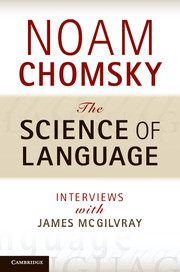Book contents
- Frontmatter
- Contents
- Introduction
- Part I The science of language and mind
- 1 Language, function, communication: language and the use of language
- 2 On a formal theory of language and its accommodation to biology; the distinctive nature of human concepts
- 3 Representation and computation
- 4 More on human concepts
- 5 Reflections on the study of language
- 6 Parameters, canalization, innateness, Universal Grammar
- 7 Development, master/control genes, etc.
- 8 Perfection and design (interview 20 January 2009)
- 9 Universal Grammar and simplicity
- 10 On the intellectual ailments of some scientists
- 11 The place of language in the mind
- 12 Chomsky's intellectual contributions
- 13 Simplicity and its role in Chomsky's work
- 14 Chomsky and Nelson Goodman
- Part II Human nature and its study
- Appendices
- Commentaries
- Glossary
- Bibliography
- Index
5 - Reflections on the study of language
from Part I - The science of language and mind
Published online by Cambridge University Press: 05 June 2012
- Frontmatter
- Contents
- Introduction
- Part I The science of language and mind
- 1 Language, function, communication: language and the use of language
- 2 On a formal theory of language and its accommodation to biology; the distinctive nature of human concepts
- 3 Representation and computation
- 4 More on human concepts
- 5 Reflections on the study of language
- 6 Parameters, canalization, innateness, Universal Grammar
- 7 Development, master/control genes, etc.
- 8 Perfection and design (interview 20 January 2009)
- 9 Universal Grammar and simplicity
- 10 On the intellectual ailments of some scientists
- 11 The place of language in the mind
- 12 Chomsky's intellectual contributions
- 13 Simplicity and its role in Chomsky's work
- 14 Chomsky and Nelson Goodman
- Part II Human nature and its study
- Appendices
- Commentaries
- Glossary
- Bibliography
- Index
Summary
JM: You used to draw a distinction between the language faculty narrowly conceived and the language faculty more broadly conceived, where it might include some performance systems. Is that distinction understood in that way still plausible?
NC: We're assuming – it's not a certainty – but we're basically adopting the Aristotelian framework that there's sound and meaning and something connecting them. So just starting with that as a crude approximation, there is a sensory-motor system for externalization and there is a conceptual system that involves thought and action, and these are, at least in part, language-independent – internal, but language-independent. The broad faculty of language includes those and whatever interconnects them. And then the narrow faculty of language is whatever interconnects them. Whatever interconnects them is what we call syntax, ‘semantics’ [in the above sense, not the usual one], phonology, morphology . . ., and the assumption is that the faculty narrowly conceived yields the infinite variety of expressions that provide information which is used by the two interfaces. Beyond that, the sensory-motor system – which is the easier one to study, and probably the peripheral one (in fact, it's pretty much external to language) – does what it does. And when we look at the conceptual system, we're looking at human action, which is much too complicated a topic to study. You can try to pick pieces out of it in the way Galileo hoped to with inclined planes, and maybe we'll come up with something, with luck. But no matter what you do, that's still going to connect it with the way people refer to things, talk about the world, ask questions and – more or less in [John] Austin style – perform speech acts, which is going to be extremely hard to get anywhere with. If you want, it's pragmatics, as it's understood in the traditional framework [that distinguishes syntax, semantics, and pragmatics].
All of these conceptual distinctions just last. Very interesting questions arise as to just where the boundaries are. As soon as you begin to get into the real way it works in detail, I think there's persuasive – never conclusive, but very persuasive – evidence that the connecting system really is based on some merge-like operation, so that it's compositional to the core. It's building up pieces and then transferring them over to the interfaces and interpreting. So everything is compositional, or cyclic in linguistic terms. Then what you would expect from a well-functioning system is that there are constraints on memory load, which means that when you send something over the interface, you process it and forget about it; you don't have to re-process it. Then you go on to the next stage, and you don't re-process that. Well, that seems to work pretty well and to give lots of good empirical results.
- Type
- Chapter
- Information
- The Science of LanguageInterviews with James McGilvray, pp. 36 - 38Publisher: Cambridge University PressPrint publication year: 2012

